2021 Portuguese & Spanish GPs: Mercedes gives them the old one, two
And in more ways than one. Hamilton is on a charge, and a superb tactical gamble paid off hugely in Spain, says Mark Hughes
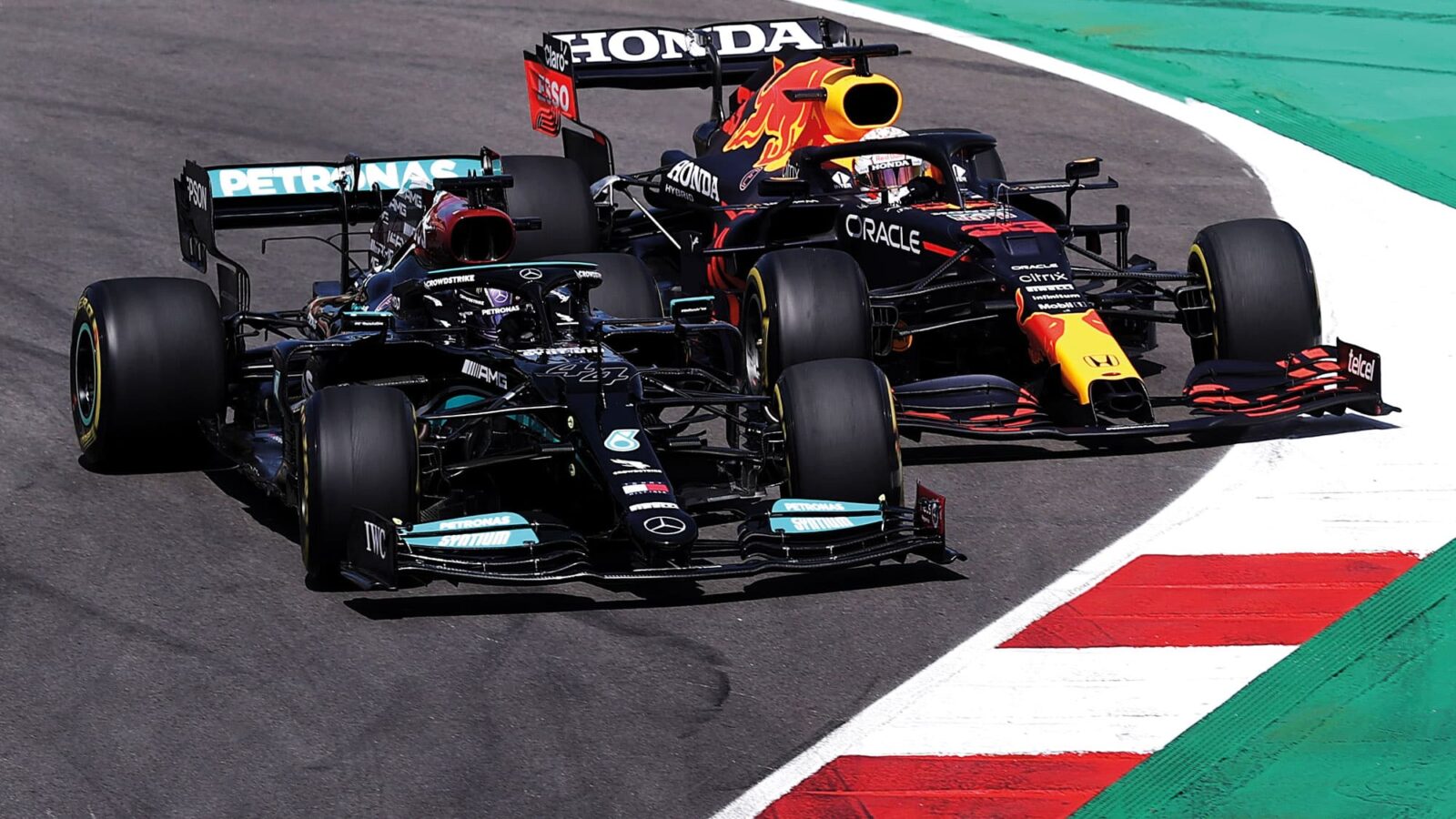
Lars Baron/Getty Images
Portimão GP | Spanish GP
These two events were something of a cold shower for the hopes raised by the first two. Bahrain and Imola had suggested a closely-matched title slug-out between Lewis Hamilton/Mercedes and Max Verstappen/ Red Bull. It’s not that Verstappen wasn’t in there fighting in Portugal and Spain – he was. It’s just that Hamilton and Mercedes emerged on top both times to make it three from the first four and that ‘Mercedes success fatigue’ seemed to hang in the air after seven straight seasons of dominance.
But actually, when analysing the patterns of performance over each of the four races, the winning differentiator on each occasion has varied. So it might just be that the sequence of the tracks in the calendar and how they reward/punish different aspects of performance has given a false narrative. Or it may just really be that Mercedes started behind, drew level and by Portimão and Barcelona pulled ahead. A third reading of the situation is that the multi-faceted nature of Hamilton’s brilliance in this mature part of his F1 career is making the crucial difference.
How much is the car and how much is the driver? That age-old question was posed extremely strongly in these two races where Hamilton’s route to victory was different each time.
Around a windy and gripless Portimão it was Hamilton’s cooler tyres which allowed him to sit hard in the wake of the car ahead through the long winding downhill final two turns and thereby remain close enough for DRS to be effective. This won him the race. Verstappen couldn’t do this – and that difference was crucial after they had each run behind pole-sitter Valtteri Bottas right from the start.
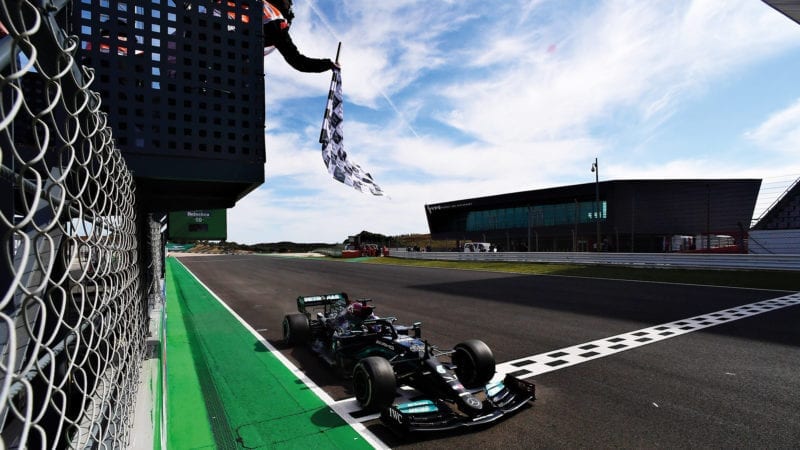
Having been trounced by Red Bull in Imola, Hamilton struck back with a dominant performance of his own in Portugal
Mario Renzi /F1 via Getty Images
Bottas led from Hamilton and Verstappen initially but an early safety car gave Verstappen the opportunity on the restart to jump Hamilton, who just happened to be looking in his mirrors to see where his rival was as Bottas ahead of them gunned it, allowing Verstappen to react quicker. For the next few laps Verstappen was giving it everything in trying to pass Bottas, who didn’t like the balance of the Mercedes on the medium tyres on which all three of them had started. Verstappen would be pushing and probing throughout the lap, terrier-like in his attack, never relenting. “But I just couldn’t get close enough in those last two corners and then the run onto the straight. It was the same later when I was behind Lewis. We just weren’t quite quick enough there.”
But why? When looking at the speed profile of the two cars when they each set their fastest laps (which came without DRS in both cases), they were virtually identical. The difference was Hamilton’s ability to come onto the straight inches from the car ahead without his tyres overheating and forcing him to lose ground. Was it a car trait or something Hamilton was doing? It could of course have been both, but it was quite clear that Hamilton’s attack followed a very different pattern to Verstappen’s. Rather than harrying the car in front throughout the lap, Hamilton would typically drop back through the twisty middle section where passing isn’t feasible. He’d then close up at will into the hairpin of Turn 13 – and your speed out of there determines how quick you will be through the long, fast double loop and onto the pit straight. Were Hamilton’s tyres cooler because he ran less aggressively for much of the lap? Was it that which allowed him to close right up under braking into the harpin? Have better traction out of it? And to retain front grip even when tight in the slipstream of the car ahead? Because all those things were true – as was the fact that Hamilton was often to be seen on an offset line to the car ahead, coming out of 14, allowing his front wing to work. As was the fact that Hamilton – unlike either Bottas or Verstappen – was staying off the serrated exit kerbs of turns 5 and 8. The significance of that? “When you drive over those serrations,” said a very recent ex-F1 driver, “it puts a lot of extra heat into the tyres because the rubber is suddenly expanding and contracting. Hamilton was hardly ever on those kerbs. The other two were on them every time.”
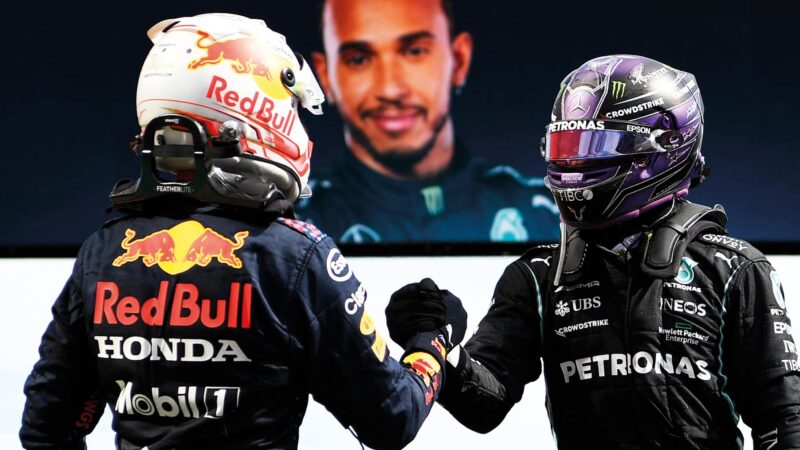
Mutual respect, but a growing rivalry regardless. Hamilton vs Verstappen promises to be a great battle this season
Gabriel Bouys/AFP via Getty Images
But it was also true that the Red Bull more readily puts heat into its tyres anyway. We’ve seen that pattern in all the races to date – how Verstappen can always nail a time on the first flying lap and how the Merc drivers, Bottas in particular, sometimes need two. That quick warm up is a great boon for Red Bull in qualifying, but may have made the winning of this race impossible for Verstappen. Maybe the only way Verstappen could have won this race would have been to control it from the front – which he might have done had his first Q3 run, good for pole, not been deleted for crossing track limits at Turn 5 when a gust of wind took him out wide.
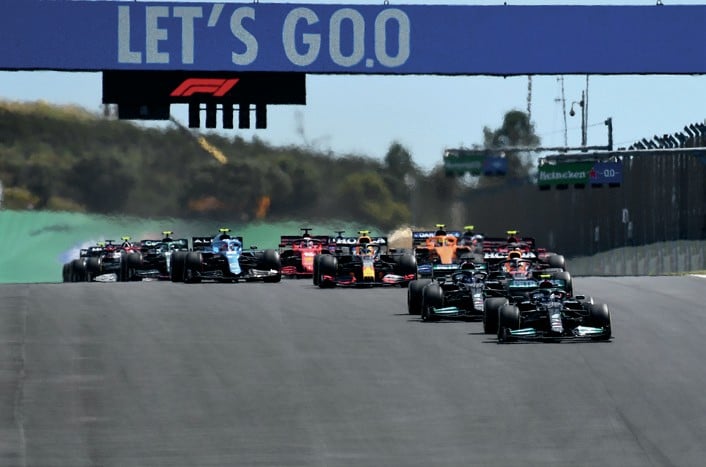
Bottas broke the Lewis-Max stranglehold on pole positions, but faded back in Portimão
Instead it played out with Verstappen getting into a bit of a tank-slapper through turn 14 as he tried extra hard to stay in Bottas’ wake – this was all the closelyfollowing Hamilton needed to slipstream past the Red Bull to retake second place. A few laps later and Hamilton took advantage of Bottas’ slower entry onto the straight to get a good DRS run going on him, then pincered him into Turn 1 and going the long – but faster – way around the outside. Once in the lead, Hamilton was gone. Verstappen later jumped Bottas for second around the pit stops. Having pitted first, Verstappen’s tyres were warmer as Bottas on his new, cold tyres locked up into Turn 3 – and Verstappen pounced.
Three laps from the end, with a big gap behind to the ‘best of the rest’ Lando Norris, Mercedes brought in Bottas for a new set of tyres with which to get the fastest lap point. The team brought him in a lap too early, for it created the space for Red Bull to bring Verstappen in next lap, and on the last lap he duly eclipsed Bottas’ time – only for it to be immediately deleted for track limits. But while they were scrapping over the white lines for the final point, Hamilton was 25sec up the road and 25 points to the good. It may have been a ‘car’ victory over Red Bull; it’s too early to say. What is certain is that Hamilton stacked absolutely everything in his favour and possibly in doing so overturned the natural car order on the day.
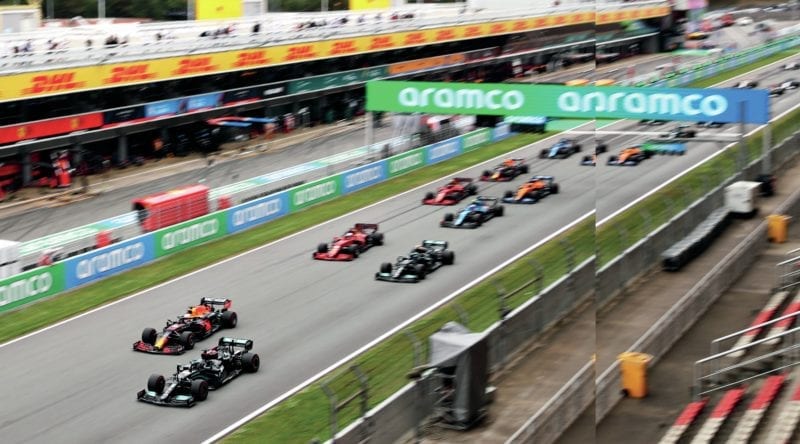
Verstappen got the better launch when the lights went out in Spain and squeezed past the Mercedes into Turn One. His momentum wouldn’t last though
The demands were altogether different in Barcelona. Here was a grippy, abrasive surface and a series of long turns, giving the tyres no time to recover in between. The tyres will always overheat here, the performance will always steadily drop away lap by lap. The more aggressive way the Red Bull works the tyres looked set to be a problem, much more so than at Portimão, where they get plenty of time to recover and where the gripless surface doesn’t induce as much heat anyway.
Red Bull was acutely aware of this coming in. Throughout Friday in Barcelona it ran with a big tyre-protecting rear wing, smothering the car in downforce. It seemed to work – in that Sergio Perez’s Red Bull set the fastest long run time of all, albeit by almost nothing over the two Mercs. Verstappen suffered a disjointed practice after twice damaging his front wing over the newly extended sausage kerbs on the exit of Turn 7. Encouraging though Perez’s pace was, a comparison of the straight-line speed between the Red Bull and the Mercedes suggested this wing would make the cars sitting ducks to Merc in the race, even if they could qualify ahead.
It was a luxury the team couldn’t afford. From Saturday onwards both Red Bulls ran rear wings with a smaller spoon-shaped section underside, with the draggy outboard ends cut away. It would lose the team the race in a different way to how it would have been lost with the bigger wing. Around Barcelona, there wasn’t a window for Red Bull between the conflicting demands of protecting the tyres and protecting its position at the end of the straight. In hindsight, the only way it might have won the race was for Verstappen to have shadowed Hamilton and tried for the undercut later. But even that would probably have been doomed – for the Red Bull was just harder on the tyres.
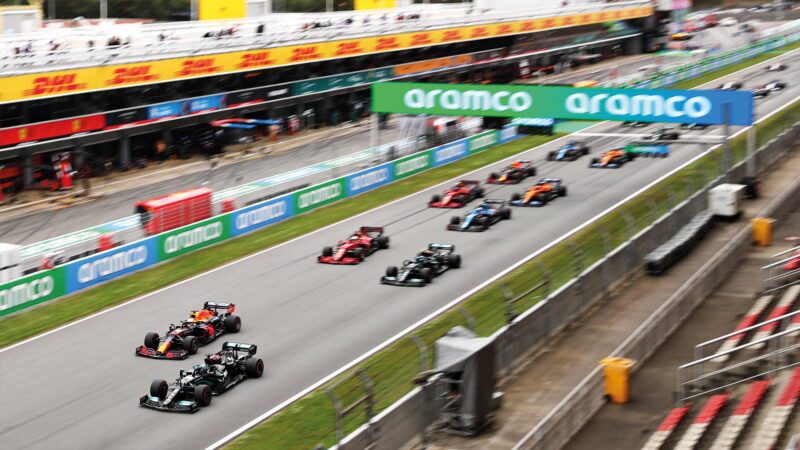
Verstappen got the better launch when the lights went out in Spain and squeezed past the Mercedes into turn one. His momentum wouldn’t last though
Joe Portlock/F1 via Getty Images
Instead, Verstappen sliced aggressively inside Hamilton into Turn 1 at the start of the race, the Merc driver having to take evasive action to avoid contact, and Max then set about driving at what he judged to be an appropriate pace for a one-stop. All the while Hamilton shadowed him, just far enough back to protect the front tyres. Their pace left the others far behind, including their respective team-mates. Bottas had been passed on the first lap by Charles Leclerc’s Ferrari and was stuck there until the first stops, though a lap 10 safety car (for Yuki Tsunoda’s broken-down AlphaTauri) gave him some of the deficit back and he was later able to undercut past the Ferrari and be in a position to support Hamilton. Sergio Perez – whose qualifying had been compromised by a shoulder problem – was stuck further behind the Ferrari/McLaren fight and therefore unable to be of any strategic help to Verstappen.
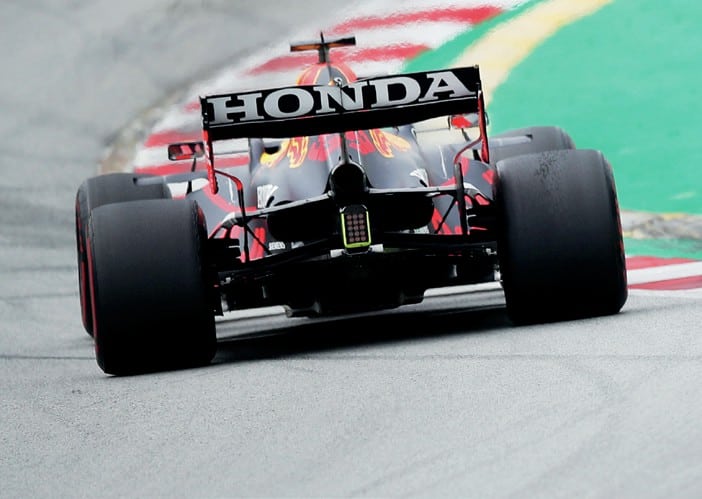
Verstappen was forced to race solo against the Mercedes after team-mate Perez’s issues in qualifying
Even though Verstappen had been beaten in Portimão, he’d enjoyed that race because “it wasn’t a race of continuously tyre-saving.” But this one was. Furthermore, the thermally-induced tyre deg turned out to be more aggressive than had been suggested on Friday – not just for Red Bull with its skinnier wing, but for everyone. Hindsight suggested that the pace Verstappen chose – and which Hamilton happily followed – in the first stint of Barcelona was too fast for a one-stop. His rear tyres began to surrender on the 23rd lap, when he dropped almost half a second from his earlier superconsistent pace. On the next lap they dropped off altogether towards the end of the lap – and he pitted, unannounced, before the tyres were quite ready.
At this point Mercedes might have been able to spring Hamilton past – as the Red Bull stop was over 4sec rather than the usual sub-2sec. But Hamilton stayed out, which rather puzzled Red Bull. Until they took a look at the tyres which had just come off Verstappen’s car: they were finished, with no tread left. With another 42 laps to go, it suddenly became apparent that this might turn out to be a two-stop race. With only a set of softs left if it needed to stop again, and with Merc having another set of mediums available, Red Bull was on the ropes, even though Verstappen continued to lead.
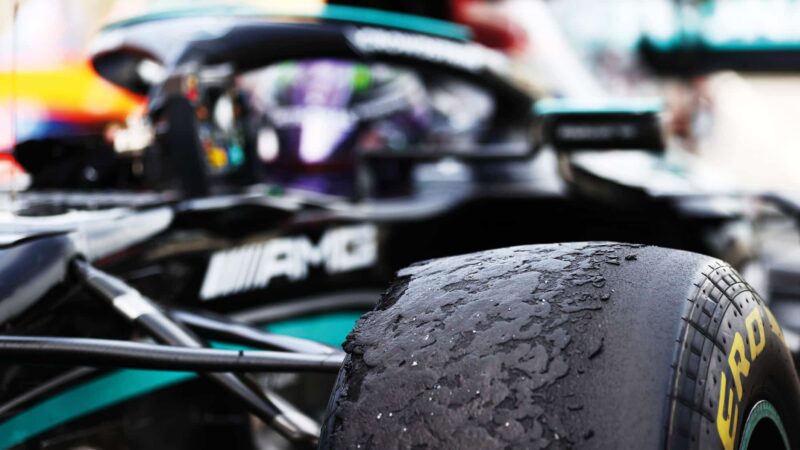
The grand prix in Barcelona came down to a straight contest in tyre wear between Mercedes and Red Bull. Hamilton’s fresher mediums bear the scars
Dan Istitene/F1 via Getty Images
It played out the way Red Bull feared, with Merc bringing Hamilton in for those mediums from just behind Verstappen with 23 laps still to go. It was Hungary 2019 all over again as Hamilton easily recovered the deficit the pit stop had cost – and, with a lot more grip, passed Verstappen without even needing to fight it out, six laps from the end.
It had been partly a strategic race, but at the heart of that strategy was a Mercedes that was simply faster over a race stint because of the easier way it uses the tyres. Maybe Verstappen’s style is harder on the tyres than Hamilton’s – he has in the last few years devoted great attention to this aspect. He seemed to be intimating something about that when he said, “I learned a lot about Max today, perhaps more than all the other races put together. This has been a good one in that sense. When you are with people on track you get to see different things and watch closely and obviously I was following relatively closely and I learned a lot about his car and how he uses it, so it was a good race in that respect.”
But the primary difference is between the cars, stark enough that it can be seen in how quickly they switch the tyres on in qualifying. All the evidence suggests that Spain was just not a winnable race for Red Bull, despite Verstappen having qualified within hundredths of Hamilton’s 100th career pole.
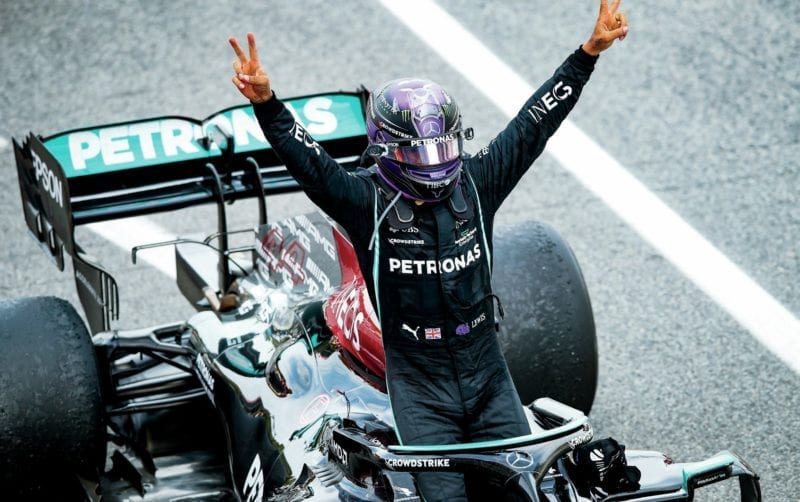
Victory in Barcelona made Hamilton the year’s first back-to-back winner, and also sealed his best-ever start to a campaign
Hamilton could only have lost this race by resisting Verstappen’s aggression into the first turn seconds after the start. A collision might have made the point that Hamilton – who’d been dumped over the kerbs at Imola by Verstappen at the beginning of the race – wasn’t about to be intimidated by Verstappen’s take-no-prisoners approach. But it was a fight he knew he didn’t need to have.
There will be plenty more fights to come across the course of this record-breaking campaign. The fascination looks set to be their different complexions from one track demand to the next.


